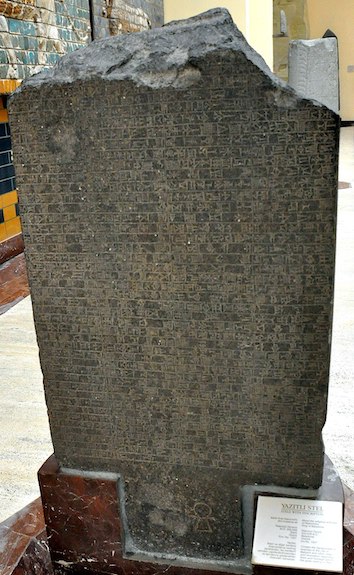Dukisikil (seat of Enmešarra and Enbilulu in Esagil at Babylon)

Dukisikil is the seat of the deities Enmešara and Enbilulu in Esagil. The Neo-Babylonian king Nabonidus (r. 555–539 BC), the last native ruler of Babylon, claims to have hung new doors in its two gateways. Although it is clear that Dukisikil was located between Marduk's seat (probably called Tiamat) in his cella Eumuša and Duku (the Dais of Destinies ) in Ubšukkina (the court of divine assembly), its precise location in Esagil is not known.

The lower half of basalt stele (Ist EŞEM 01327) that is inscribed with a long Akkadian inscription of the Neo-Babylonian king Nabonidus. The so-called "Babylon Stele" records that ruler's work on Esagil, including providing the Dukisikil's gates with new doors. Image reproduced via Creative Commons Attribution-Share Alike 4.0 (CC BY-SA 4.0) license via Wikiwand.
Names and Spellings
The Sumerian ceremonial name of this part of Esagil means "Mound, Pure Place."
- Written Forms: du₆-ki-sikil; du₆-ki-sikil-la.
Known Builders
- Neo-Babylonian (ca. 625–539 BC)
- Nebuchadnezzar II (r. 604–562 BC)
- Nabonidus (r. 555–539 BC)
Building History
An Akkadian inscription of the Neo-Babylonian king Nabonidus written on a broken basalt stele records that he renovated and refurbished some of the principal gateways of Esagil, including the two entrances of Dukisikil, principally by providing them with new wooden doors.The relevant passage of the so-called "Babylon Stele" reads:
Archaeological Remains
Dukisikil has not yet been positively identified in the archaeological record. It has been tentatively suggested that it should be identified as Marduk's ante-cella (= Room 18). This is suggested on the assumption that Ubšukkina (the court of divine assembly) was located in the Court of Bēl (the central courtyard of the main part of Esagil). Alternatively, Dukisikil could have been Room 19, the chamber situated in the main part of Esagil between the Court of Bēl and the courtyard of the eastern annex building. This interpretation assumes that Ubšukkina should be identified as the courtyard of the eastern annex building. At present, the issue cannot be resolved given the lack of firm evidence.
Further Reading
- George, A.R. 1992. Babylonian Topographical Texts (Orientalia Lovaniensia Analecta 40), Leuven, pp. 277 and 289.
- George, A.R. 1993. House Most High. The Temples of Ancient Mesopotamia (Mesopotamian Civilizations 5), Winona Lake, p. 77 no. 177.
- Pongratz-Leisten, B. 1994. Ina Šulmi Īrub: Die kulttopographische und ideologische Programmatik der akitu-Prozession in Babylon und Assyrien im 1. Jahrtausend v. Chr. (Baghdader Forschungen 16), Mainz am Rhein, pp. 54–55.
Banner image: areal photograph of the excavation pits and trenches in the area of the remains of Esagil and Etemenanki taken in 1923 (left); a reconstruction of Esagil and Etemenanki during the reign of the Neo-Babylonian king Nebuchadnezzar II (center); a plan of Esagil, and Etemenanki (right). Images from O. Pedersén, Babylon: The Great City, pp. 144–145 figs. 4.3–4.4 and p. 151 fig. 4.11.
Jamie Novotny
Jamie Novotny, 'Dukisikil (seat of Enmešarra and Enbilulu in Esagil at Babylon)', Babylonian Temples and Monumental Architecture online (BTMAo), The BTMAo Project, a sub-project of MOCCI, [http://oracc.org/btmao/Babylon/TemplesandZiggurat/Esagil/RoomsandGates/Dukisikil/]